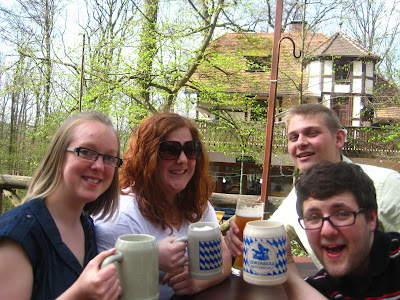I'm currently on day 2 of my 8 days of down time for the month of April. I had a fabulous week with Kristen - we visited Bamberg (twice [I mean, she did study abroad there]), enjoyed a few good beers, and played the dice game pretty much everywhere we went. I don't know how Kristen knew that Gemma and I LOVE playing games (definitely not from this post, this post or this post...), but she showed up armed and ready on Monday with a bag of dice and a, as we would come to discover, very addicting game.
What is "the dice game"? Well, that's what I'm going to explain. I've decided for the next 4 or 5 days until I leave for Munich I'm going to share a game a day of games (mostly cards) that I have learned from my Franken friends and a couple that were my favorite from home (what can I say, I was raised with cards in my hand). We'll kick things off with the game that has been consuming my time for the past week. Unfortunately it doesn't have a real name yet, so we'll just call it "the dice game" (however, I am open to suggestions).
THE DICE GAME (2 or more players... although you can play by yourself. I will neither confirm nor deny that I've done that at some point in the last week)
What you need: 6 regular dice (6 sided, that is)
Objective: to have the highest score
 |
The total possible value of this roll
would be 550 points, the extra 4
holds no point value and must be
rolled again or the turn ends
accepting the 550 points |
Scoring: dice showing 5 dots = 50 points, dice showing 1 dot = 100 points, 3 of a kind* = the number showing x 100 (e.g. three dice showing 4 dots is 400 points), a straight of 1 through 6* = 1100 points, 6 of a kind (on one roll) = Game over, you win, you probably just kick-started the apocalypse. To count your score for the turn, you must roll at least 300 points, for your first score on the board you must roll at least 400 points.
*Note: the only score sets are 3 of a kind or a straight of 6. 4 or 5 of a kind or a straight of less than 6 hold no extra value. Also, combinations always take the highest possible point value; therefore, if a player rolls three 1's, the score would be 300 points, while a player rolling three 5's would count it as 500 points.
 |
with this roll, the player
must count the 5 to
continue rolling |
Taking a turn: players take turns rolling all 6 dice. For each roll you must have at least 1 scoring die* to continue your turn. Each die you count towards your score may not be rolled again until all 6 dice have been counted towards your score, at which point you start again with all 6, taking out dice as they continue to add to your score. Your turn ends in one of two ways: 1. you don't roll any points. Once you have a roll with no points in it (i.e. no 1's, 5's, 3 of a kinds or straights of 6) you automatically lose all the points you saved during that turn and your turn is over. 2. Once you reach the minimum of 300 points (or 400 for the first time scoring), you have the option with every roll to either stop and take the points or continue rolling and risk ending with no points.
*Note: you do not have to count every scoring die in a roll. For example, if the player rolls a 1 and two 5's, he or she may choose to only keep the 1 and re-roll the 5's for a better chance of scoring on subsequent rolls.
Ending the game: Once the first player reaches 5000 points, the game ends and each player (besides the player to reach 5000) gets one final turn. In their final turn they must roll until they a. gain no points by rolling a turn without scoring or b. surpass the original winner's score. Once a player surpasses the original score he or she has the option of continuing and risk losing his or her entire score or stopping to count the points. Even if the original player to reach 5000 points has his or her score surpassed by another player on the final roll, he or she does not get a chance to roll again.
I hope you enjoy this very simple game as much as we have this past week!
Tomorrow's game: Uncle Stuart's Game
 I'm going to bed now with the excitement of a small child on Christmas eve. My crown is neatly in place and my royal wedding mug (a gift from Gemma's grandmother) on the side table with William and Catherine watching over me - waiting for royal wedding Santa to come spread the joy and cheer of this momentous occasion.
I'm going to bed now with the excitement of a small child on Christmas eve. My crown is neatly in place and my royal wedding mug (a gift from Gemma's grandmother) on the side table with William and Catherine watching over me - waiting for royal wedding Santa to come spread the joy and cheer of this momentous occasion. 























